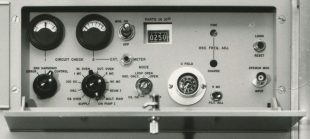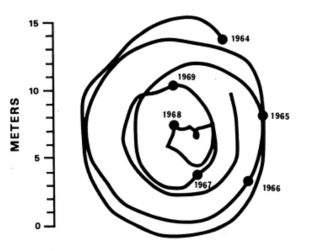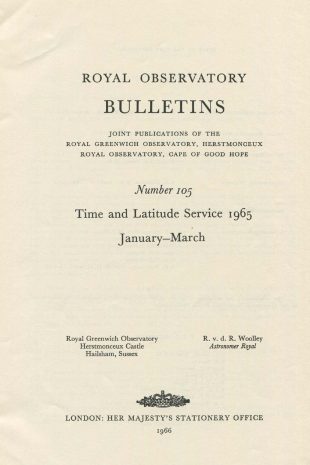…where east meets west
- Home
- Brief History
- The Greenwich Meridian
- Greenwich
(1675–1958) - Herstmonceux
(1948–1990) - Cambridge
(1990–1998) - Outstations (1822–1971)…
- – Chingford (1822–1924)
- – Deal
(1864–1927) - – Abinger
(1923–1957) - – Bristol & Bradford on Avon
(1939–1948) - – Bath
(1939–1949) - – Hartland
(1955–1967) - – Cape of Good Hope
(1959–1971)
- Administration…
- – Funding
- – Governance
- – Inventories
- – Pay
- – Regulations
- – Royal Warrants
- Contemporary Accounts
- People
- Publications
- Science
- Technology
- Telescopes
- Chronometers
- Clocks & Time
- Board of Longitude
- Libraries & Archives
- Visit
- Search
The atomic clocks of the Greenwich Time Service
Built and operated by the National Physical Laboratory at Teddington in west London, the world's first operational frequency standard based on the atomic properties of the element caesium, was bought into use in 1955. Often referred to as an atomic clock, it immediately set a new standard in global timekeeping and gave birth to atomic time.
Less than ten years later, in 1964, Hewlett-Packard produced the world's first commercial atomic clock built entirely with solid state components. Given the model number HP5060A, it was one of these that the Observatory acquired as its first atomic clock in 1966. By 1974, it had a total of six – two HP5060As and four of its successor the HP5061A.
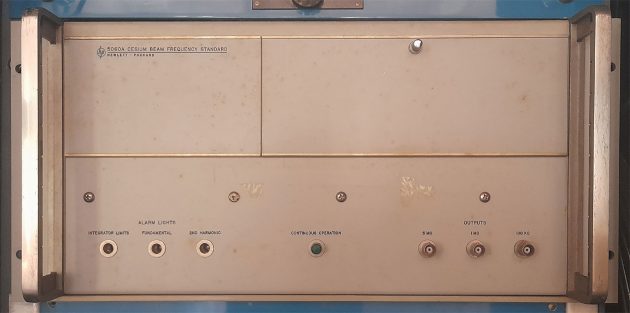
One of the Observatory's two Hewlett Packard model 5060A atomic clocks photographed in May 2024 at the Museum of Timekeeping at Upton Hall in Lincolnshire. The other clock is in the collections of the Science Museum in London
In October 1967 an international atomic time scale (IAT) began to be computed for the first time from the independent atomic time scales of seven of the world's major national time services, including that of the Royal Observatory. From July 1973, it was constructed instead from the rates of individual clocks that were weighted according to their recent performance. At the same time, the acronym was changed from IAT to TAI.
At the Observatory, as well as producing a local atomic time scale and contributing to the international atomic time scale, the clocks were used to monitor changes in the rate of the Earth's rotation, to produce the Greenwich Time Signal, and to compare time signals from around the world with a view to improving their synchronisation.
The Observatory's Time Department remained at the forefront of international timekeeping until the mid-1970s when it was given a lower funding priority by the Observatory's Director. In the mid-1980s, the Observatory's then funder, the Science and Engineering Research Council (SERC), withdrew the bulk of its financial support for the Time Service, leading to its complete closure in 1990.
From the 1940s onwards, the Time Department was in a state of continuous flux as new techniques and instrumentation were developed. Considerable further research is required in order to piece together a complete history.
The Hewlett-Packard models HP5060A and HP5061A
Whilst the valves (vacuum tubes) used in the construction of earlier atomic clocks had made them comparatively large and fragile, the solid-state components of the HP5060A not only made it more reliable, but also transportable while running. Launched in 1964, the HP5060A was superseded by model HP5061A in 1967, which was later superseded by model HP5061B in 1986.
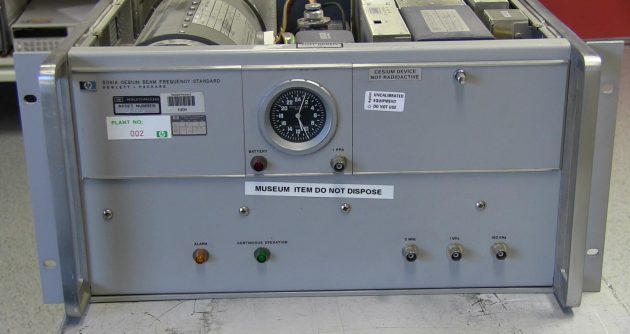
A typical HP5061A model. It was not however one of the ones owned by the Observatory. This particular one was used in the famous Hafele–Keating experiment. Photo date February 2013. Reproduced under a Creative Commons Attribution 2.0 Generic license (CC BY 2.0) courtesy of Dave Jones and (see below)
Model 5071A, which was unveiled in 1991, was a direct descendent of and replacement of the earlier caesium standards and by the year 2000 was being sold with a guaranteed tube life of 10 years - roughly eight times longer than those of HP5061A had been given in 1968. By the time of its introduction however, the Observatory's Time Department had been shut down and the Observatory relocated to Cambridge.
The transportability of the Hewlett-Packard models enabled direct comparisons to be made between different clocks around the world, thereby allowing errors and delays in time signal transmissions to be more accurately assessed. Visits by travelling clocks were a regular feature at Herstmonceux until at least the mid-1970s. More on this below.
Temporary Operating Manual Hewlett-Packard model 5061A
Images showing parts of an HP5060A (LeapSecond.com)
Images of the different models of HP clocks (LeapSecond.com)
The naming of the Observatory clocks
The caesium tubes supplied with the earlier models of the HP clocks tended to have a much shorter life compared to those of the clocks produced today. In 1968, the tubes of model HP5061A had a guaranteed running life of just 10,000 hours (just under 14 months). When a tube needed replacing, the clock was sent back to the manufacturer and assigned a new name operating name by the Observatory on its return. Broadly speaking, the clocks were named CsA, CsB, CsC etc, in their order of arrival or return to the Observatory after a tube replacement. CsA for example was later renamed as CsC, then CsK, then Csl.
Information published by the Observatory about the arrival of new clocks and tube replacements tends to be incomplete, scattered, and inconsistent in its detail. The information in the first table below covers the period up to the end of 1978. It has been compiled from the Time and Latitude Bulletins/Greenwich Time Reports (see below) with confirmation in some cases coming from the more general Observatory Reports which from 1966 until 1980 were normally issued annually but occasionally after intervals of nine or 15 months.
From the start of 1977, following the departure of Humphry Smith as officer in charge of the Time Department, the scope of the information published in the Greenwich Time Reports was slightly altered. On the plus side, the rates of all the running clocks were published for the first time. On the downside, no information was published on how existing clocks were renamed after a tube replacement. Although it is possible to deduce that CsB was renamed CsN and that that CsF was renamed CsN, it has not been possible to identify the parenthood of all the clocks from 1979 onwards. The last of the Greenwich Time Reports to be published covered the second quarter of 1982.
If the (annual) Observatory Reports are to be taken at face value, the Observatory never owned more than six clocks. The Greenwich Time Reports however show that there were several occasions when details of seven observatory clocks were published, as can be seen in the third table below. It appears however than even these did not represent the true picture as in the Proceedings of the Nineteenth Annual Precise Time and Time Interval (PTTI) Applications and Planning Meeting, Redondo Beach, CA, 1-3 Dec 1987, Tony Seabrook mentions that in the best years, the Observatory had eight operational standards.
Table showing date of acquisition or renaming of the six caesium clocks 1966 – 1978
Clock |
Model |
Date |
Name |
Information Source7 |
| 1 | HP5060A1 | 1966, May 63 | CsA | B140 |
| 1968, Mar (by) |
CsC | GTR1968Q1,p.9 | ||
| 1974, Apr | CsK | GTR1974Q3,p.39 | ||
| 1975, Mar 21 | CsL | GTR1975Q1,p.80 | ||
| 2 | HP5060A | 1967, Mar 33 | CsB | B149, GTR1968Q1,p.9 & GTR1968Q1,p.9 |
| 1977, Nov 2 (by) | CsN | GTR1977Q4,p,66 | ||
| 3 | HP5061A | 1968, Aug 296 | CsDc/CsD | GTR1968Q4,p.51 & GTR1968Q1,p.9 |
| 1972, Mar 30 ? | CsG | GTR1972Q1,p.264 & GTR1972Q2,p.281 | ||
| 1975, Nov | CsM | GTR1975Q4,p.139 | ||
| 4 | HP5061A | 1970, Sept |
CsE | IAU, Vol 15A, p.427 & QJRAS |
| 1973, Aug 23 | CsH | GTR1973Q3,p.369 | ||
| 5 | HP5061A | 1972, Jan 14 | CsF | GTR1972Q2,p.281 |
| 1978, Jul (By)5 | CsP | GTR1978Q3,p.110 | ||
| 6 | HP5061A2 | 1974, Dec | CsJ | GTR1974Q4,p.61, 1976IAUTA..16a.159E |
1. Wilkins (2009) records it had originally been scheduled for delivery in August 1965. Bulletin 140 states: A frequency of 100 Hz derived from the caesium-controlled crystal oscillator is connected to the beat counters to give comparisons with the other quartz crystal oscillators of the Time Department.
2. Tube Option 4.
3. Described in Bulletin or Report as 'installed in ...'. CsB returned to Hewlett-Packard for a new tube on 19 October 1976 (GTR1976Q4, p235).
4. Received on January 1 and put on test on high beam current; on being moved on March 24, there was a change of rate; it was installed in its cellar on May 26 and the C-field adjusted on May 31. IAU, Vol 15A, p.427 gives the date of arrival (presumably in error) as January 1971.
5. CsF last mentioned on 1978, Jan 1 (GTR1978Q1, p.82).
6. CsDc was installed on 29 August 1968. Running on UTC rate, CsD was derived from CsDc by applying the difference in rate between atomic time and UTC i.e., 2.592 msec/day. Brought into operational use on 1 December 1968. GA2 was determined from CsB during October and November and from the mean of CsB and CsD in December (Greenwich Time Report, 1968 Oct-Dec, p51).
7. B = Royal Observatory Bulletin, GTR = Greenwich Time Report, Q1 = quarter 1 etc.
Table showing appoximate dates clocks A – M existed between 1966 & 1976
Date |
Months |
Total |
Comment |
|||||||||||||||
| 1966 May | – | 1967 Mar | 11 | A |
1 | A new |
||||||||||||
| 1967 Mar |
– | 1968 Mar |
13 | A | B | 2 | B new |
|||||||||||
| 1968 Mar |
– | 1968 Aug |
6 | B | C | 3 | A renamed C |
|||||||||||
| 1968 Aug |
– | 1970 Dec |
29 | B | C | D | 3 | D new |
||||||||||
| 1970 Dec |
– | 1971 Dec |
13 | B | C | D | E | 4 | E new |
|||||||||
| 1972 Jan |
– | 1972 Mar |
3 | B | C | D | E | F | 5 | F new |
||||||||
| 1972 Mar |
– | 1973 Aug |
18 | B | C | E | F | G | 5 | D renamed G |
||||||||
| 1973 Aug | – | 1974 Apr | 9 | B | C | F | G | H | 5 | E renamed H |
||||||||
| 1974 Apr | – | 1974 Dec | 9 | B | F | G | H | K | 5 | C renamed K |
||||||||
| 1974 Dec1 | – | 1975 Mar | 4 | B | F | G | H | J | K | 6 | J new |
|||||||
| 1975 Mar | – | 1975 Nov | 9 | B | F | G | H | J | L | 6 | K renamed L |
|||||||
| 1975 Nov | – | 1976 end | 14 | B | F | H | J | L | M | 6 | G renamed M |
1. Date run started rather than date of acquisition
Table showing clocks mentioned in each quarterly
Greenwich Time Report Jan 1977 to Jul 1982
Year |
Qtr. |
Total |
|||||||||||||||||
| 1977 | Q1 | F | H | J | L | M | 5 | ||||||||||||
| Q2 | F | H | J | L | M | 5 | |||||||||||||
| Q3 | F | H | J | L | M | 5 | |||||||||||||
| Q4 | F | H | J | L | M | N8 | 6 | ||||||||||||
| 1978 | Q1 | F | H | J | L | M | N | 6 | |||||||||||
| Q2 | H | J | L | M | N | 5 | |||||||||||||
| Q3 | H1 | J | L | M6 | N | P9 | 6 | ||||||||||||
| Q4 | L | M7 | N | P | 4 | ||||||||||||||
| 1979 | Q1 | L |
M | N | P | 4 | |||||||||||||
| Q2 | L | M | N | P | Q4 | 5 | |||||||||||||
| Q3 | L |
N | P | Q | 4 | ||||||||||||||
| Q4 | L | N | P | Q | R5 | 5 | |||||||||||||
| 1980 | Q1 | L | N | P | Q | R | S2 | T3 | 7 | ||||||||||
| Q2 | L | N | P | Q | R | S | T | 7 | |||||||||||
| Q3 | L | N | P | Q | R | S | T | 7 | |||||||||||
| Q4 | L | N | P | Q | R | S | 6 | ||||||||||||
| 1981 | Q1 | L | N | P | Q | R | S | 6 | |||||||||||
| Q2 | L | N | P | Q | R | S | T |
7 | |||||||||||
| Q3 | L | N | P1 | Q | R | S | T | 7 | |||||||||||
| Q4 | L | N | Q | R | S | T | 6 | ||||||||||||
| 1982 | Q1 | L | N | Q | R | S | T | 6 | |||||||||||
| Q2 | L | N | Q | R | T | V | 6 |
1. Taken out of service in July
2. From February
3. From March
4. From June
5. From Dec
6. Taken out of service in August
7. Brought back into service in October
8. From November. Assumed to be a replacement for CsB
9. Assumed to be a replacement for CsF
The sixth clock (CsJ), which arrived in 1974, was supplied with a 'high performance tube'. By 1979, three of the clocks had been fitted with such tubes (Reports on Astronomy 1979)
The location of the clocks at Herstmonceux
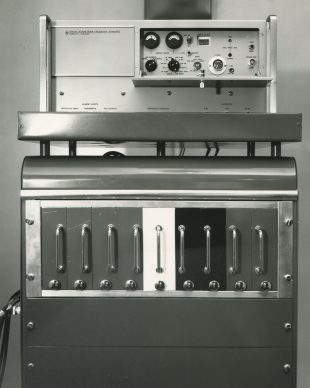
One of the HP5060A clocks in operation in 1973 in its cellar at sub-basement level. Humphry Smith Photographic Archive
Neither the Bulletins nor the Greenwich Time Reports mention where at Herstmonceux the atomic clocks were located. Nor did any of the Observatory Reports until the Report for the period 1 October 1980 - 30 September 1985 which states: 'The clocks are kept in six locked, temperature controlled rooms in an air condition sub-basement and have individually stabilised external DC power supplies.' Some information was however published in 1973 when in his paper Facilities and services in the Time Department of the Royal Greenwich Observatory. Proceedings of the 5th PITI Planning Meeting, NASA Goddard Space Flight Center Smith wrote:
'The time department now operates five caesium standards, which are housed in cellars at sub-basement level. Each standard has an independent earthing system, an individual emergency power supply, and the distribution of time and frequency is by buffered screened balanced lines, On initial installation, each standard is carefully set up according to the manufacturers recommended procedure, the C-field being adjusted to the optimum level. No subsequent frequency adjustment is made by off-setting the C-field. In these strictly controlled conditions, the standards are capable of a stability of mean rate over periods of weeks of better than 0.01 microseconds per day. (1in 10l3). The rates of individual standards can differ by as much as 0.5 microseconds per day, and occasional inexplicable changes of rate of a few tenths of a microsecond per day can occur.'
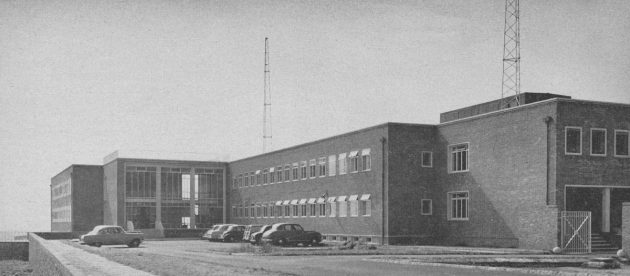
The West Building shortly after its completion in 1957. The Time Department's control room was in the basement, whose windows cab be seen immediately in front of the row of parked cars. The clock cellars were located beneath them in the sub-basement. The towers on the roof supported an aerial for the reception of time signals. From a photograph published in 1958
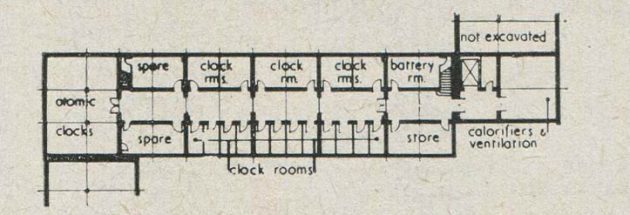
Plan of the sub-basement level of the West Building showing the location of the clock cellars (marked clock rms). Each cellar was designed to hold just one clock. The smaller rooms were where the quartz clocks had been installed. It is not presently known which rooms were used for the suite of atomic clocks. From a plan published in 1958
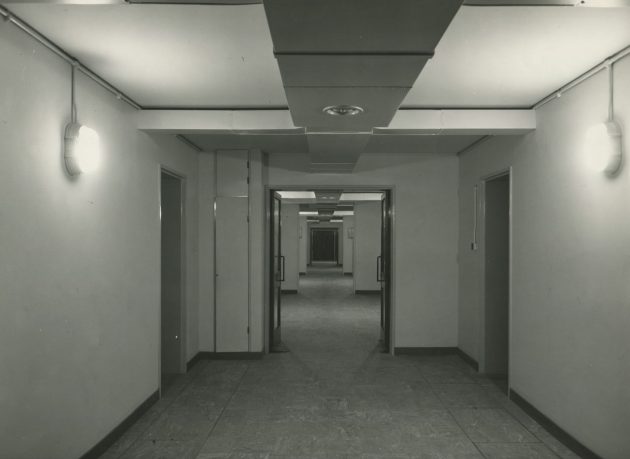
Looking southwards along the clock cellar corridor towards the double doors of the cellar originally constructed for a future atomic clock at the far end. The door on the right corresponds to the door of the battery room in the 1958 plan above. Humphry Smith Photographic Archive
Better clocks need better telescopes
One of the major tasks of a timekeeping observatory was the determination of astronomical time. The increased precision in timekeeping that came with the introduction of quartz crystal clocks to the Observatory in the 1940s brought with it a requirement for a corresponding increase in the precision of time determinations. To this end, a small instrumentation laboratory was formed, and Dudley Perfect, working closely with Grubb Parsons of Newcastle, designed a Photographic Zenith Tube (PZT). Although technically a zenith instrument, its mode of operation was more akin to that of a highly specialised transit instrument. Sited with the meridian instruments to the north of the castle at Herstmonceux, operations with the PZT commenced in 1955. It took over time-determination from Small Transit C on 16 October 1957. Modified in later life, operation of the PZT ceased on 30 June 1984 due to a withdrawal of funding from the time department. In 1958, Perfect estimated the probable error of the time determined from observations on one night was of the order of ± .003s (ONRAS, No.21, (1959). This compared to a figure of ± 0.03 s quoted in 1948 in Post Office Engineering Department, Radio Report No.1752 for the small reversible transit telescopes that preceded it.
The introduction of new time scales in the 1950s
Although long term and irregular variations in the speed of the Earth had been suspected from the eighteenth century onwards, it was not until the advent of better time keepers in the form of the Shortt free-pendulum clock together with the subsequent analysis of the observed motions of the Sun, Moon and planets which was published by Spencer Jones in 1939, that the necessity for a new astronomical timescale independent of the rotation of the Earth became evident.
Discussions about its introduction began in the late 1940s, with a new definition being adopted by the General Assembly of the International Astronomical Union (IAU) in Rome in 1952. Instead of being taken as 1/86,400 of a day as it had been the case in the past, the second was now defined as a fraction of a year. But because years, like days, also vary in length, the specific year of 1900 was chosen. Various names for the new timescale were considered including ‘Newtonian time’ and ‘uniform time’ time but in the end, the name which ended up being adopted was ‘ephemeris time’.
Following further discussion, it was deemed desirable to tweak the new definition of the second and change the type of year referred to from the sidereal year (which is measured by reference to the stars) to the tropical year (which is measured with reference to the seasons and is around 6 minutes shorter). The change from sidereal year to tropical year was adopted by the IAU in 1955. In science speak; the second was now defined as 1/31,556,925.975 of the tropical year for 1900.0. In 1956, this value was adjusted to 1/31,556,925.9747 of the tropical year for 1900 January 0 at 2 hours ephemeris time. This definition was enshrined in the new system of International System of Units (SI) that formally came into being in 1960. As such, it became the definition used by everyone rather than just astronomers.
Although the new definition had the great advantage that the length of the second was no longer prone to vary slightly form one day to the next, it had the great disadvantage that it was rooted in the past and as a result was a very difficult standard with which to make comparisons. But perhaps the biggest downside of ephemeris time was that it could only be computed in arrears and was of no practical value in controlling time signals, which by the 1950s was the key role of the Time Department at the Observatory.
Meanwhile, other developments had being going on. In his Reports to the Board of Visitors, the Astronomer Royal recorded that at the Royal Observatory, the astronomical observations of time had been corrected for the effects of polar variation since 1948 , and for the seasonal fluctuation since October 1949 , thus providing a quasi - smooth time system which was given the name of "Provisional Uniform Time" (PUT). The first time this was mentioned in the Time Service section of the volumes of Greenwich Observations, appears to have been in the volume for 1951. By 1955 the BIH found that four independent systems or correction had come into use among participating observatories. From the start of 1956, UT (Greenwich mean solar time calculated from the observed sidereal times of transit of a number of stars across the instantaneous meridian of the observer) became known as UT0 and UT1 and UT2 were introduced, UT1 being UT0 corrected for polar motion; and UT2 being UT1 corrected for extrapolated seasonal variation.Meanwhile, back in 1955, at the National Physical Laboratory in London, the world's first operational caesium frequency standard had set a new standard in timekeeping; proving more stable than the quartz clocks which had been developed in the 1930s and 40s. More importantly, it proved to be a more stable timekeeper than the Earth. Atomic time also had an important practical advantage over ephemeris time, in that it was easily obtainable for comparative purposes. As a result, a new definition for the second was drawn up whose value was equal to the observationally determined value of the ephemeris second.
International Atomic Time (TAI) and the Greenwich Atomic Time scales, GA, GA2 and TA(RGO), and
Built by Louis Essen and Jack Parry, the National Physical Laboratory's first caesium standard was given the name Cs1. It was described by them as a caesium resonator that could be used for calibrating existing quartz standards to a claimed accuracy of ± 1 part in 109 (0.0001 seconds a day). Like all clocks, and unlike timekeeper Earth, Cs1 could not run continuously. In order to create a continuous atomic timescale, atomic time had to be transferred back and forth between individual quartz clocks or groups of quartz clocks as they were taken in and out of service.
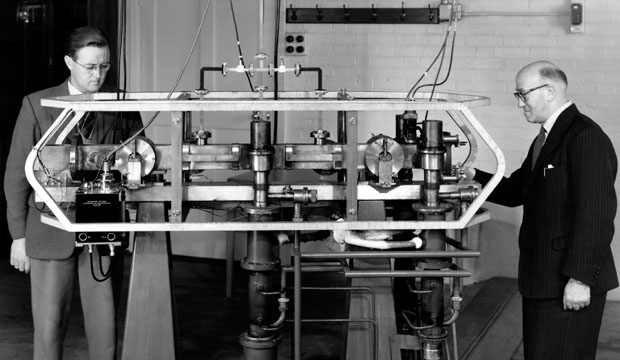
Jack Parry (left) and Louis Essen with the frequency standard Cs1 in 1955. Image from Wikimedia Commons
Although in 1955, the Royal Observatory had no atomic clock of its own, it was able to create its own atomic time scale, by indirectly calibrating the best of the quartz clocks to which it had access against the NPL quartz clocks that had been calibrated against Cs1, of which there were initially two – Q26 which had been calibrated directly and Q13 which had been calibrated indirectly by comparing it with Q26.
The local atomic timescale kept by the Observatory underwent a series of adjustments and name changes over the years. Their names and their date of origin are as follows:
Name |
Start Date |
|
| Unnamed | 1955 Jun | |
| GA | 1965 Jan | |
| GA2 | 1968 | |
| TA(RGO) | 1977 Jan 1 |
When the Observatory time scale commenced in June 1955, its initital value was chosen so that it was in agreement with PUT and the caesium transition frequency determined as 9,192,631,830 ± 10 c/s (of PUT).
Due to changes in the rate of rotation of the Earth, which gave rise to variations in PUT, the measured frequency of the caesium resonance in terms of PUT was not constant. From mid-1955 to mid-1957 the rate of rotation of the Earth progressively decreased, corresponding to an increase in the length of the day of approximately 0.45 msecs per year and an increase of approximately 5 parts in 109 per year in the frequency of the caesium resonance in terms of the PUT second. Between mid-1957 and March 1960, the average rate of rotation of the Earth remained relatively constant. corresponding to a caesium resonance frequency of approximately 9,192,631,910 c/s.
In his 1959 Report, the Astronomer Royal explained how the Observatory clocks were calibrated against Cs1:
'The frequency of the National Physical Laboratory clock Q26 is measured every few days in terms of the caesium standard and the results are communicated to the Royal Observatory. This arrangement permits comparisons between the atomic frequency and the frequency defined by U. T. 2 derived from the Herstmonceux P. Z. T. observations.'
going on to say in his 1960 Report:
'The atomic standard does not define a continuous time scale but it may be used for the periodical assessment of the frequencies of selected quartz clocks; thus with the aid of the quartz clocks a time scale may be defined, and this has been done independently on the two clocks H12 and EB. Results from the two clocks are in good agreement, but, over a period of four years, the discrepancy between the two clocks has at times amounted to two milliseconds.'
In his 1961 Report, he gave details for the first time of how this was done at Herstmonceux:
'The Post Office clock EB, which operates beat counters at the Observatory, has now completed nearly twelve years of continuous operation, and has proved of great value in the analysis of observations covering a number of years. The frequency of the N. P. L. clock Q13 is measured in terms of the caesium resonance and, since Q13 operates beat counter at Herstmonceux, the calibration may be transferred to other clocks.'
The 1961 Report covered the 12 months up to 31 March 1961. Immediately after this, the NPL quartz clock used for comparison purposess was switched from Q13 to Q32.
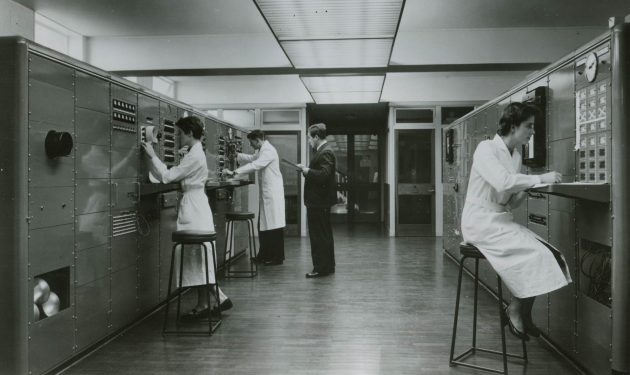
The Time Department Control Room in April 1958. On the right the beat counters used to compare the rates of the different clocks are being examined. Three of the eight sets are yet to be installed and one set has been blanked out with tape. To the left of the clock is a card bearing the time 09 57 30 and another carrying the initials of the observer E.W. (E.N.Walker). To the right, three more cards show the date (the year, the month and the day). The cards and beat counters were automatically photographed each morning at the time shown to the left of the clock. On the left side of the photo, time signals from overseas are being received and compared with the Herstmonceux clocks. The two women are thought to be Stella Francis and Dorothy Preece. The two men are Roy Wallis and the Head of the Time Department, Humphry Smith (holding a clip-board). The photo was taken looking northwards. The staircase leading to the floor above is visible though the double doors. British Information Service photograph issued April 1959
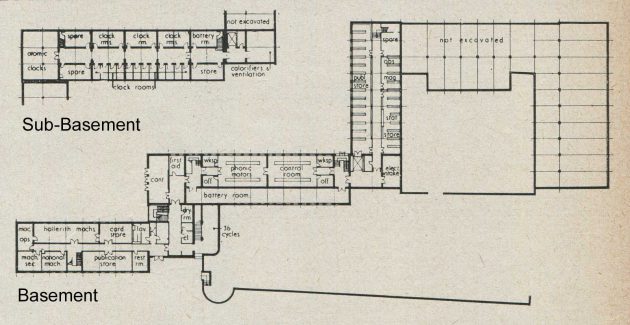
Plan showing the basement and sub-basement levels of the West Building. The Control Room and Phonic Motor Room were located in the basement immediately above the clock cellars. North is to the right and south to the left. From a plan published in 1958
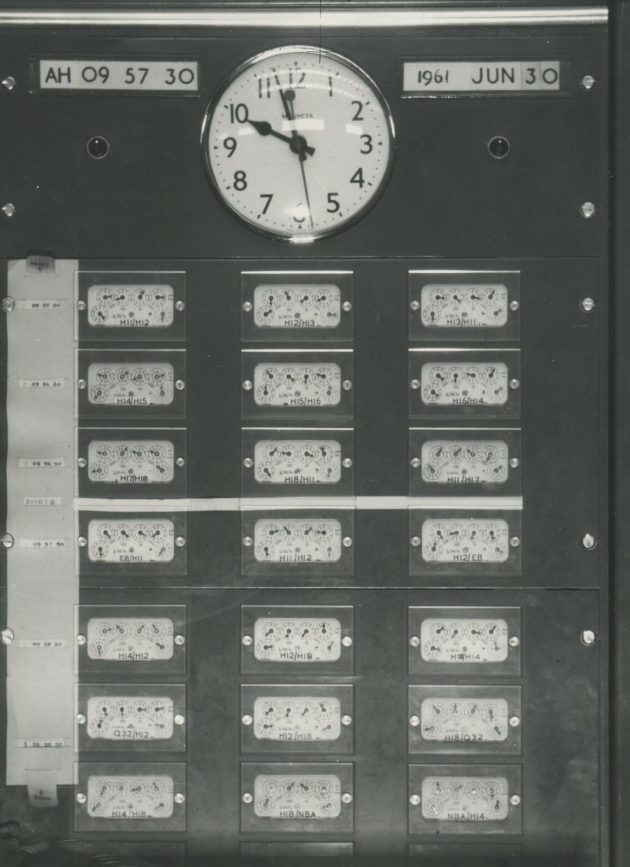
A close up view of the Beat Counters on 30 June 1961. The initials AH stand for Miss A. Heather, who was one of the Scientific Assistants working in the Department. Each display gives the name of the two clocks being compared. The clocks H11– H18 were the Herstmonceux clocks. The other clocks were located elsewhere. They were the GPO clock EB at Dollis Hill and the NPL clock Q32. Two of the beat counters on the bottom row show comparisons between the clocks H14 & H18 and the NBA time signals broadcast by the U.S. Naval Observatory. Humphry Smith Photographic Archive
In 1955, the Time Department was preparing for its move from Abinger and Greenwich to its new home at Herstmonceux. The first of the quartz clocks to be set up there were set going in early 1957 and given the names H11, H12 and H13. In view of the pending move, the first clock the Observatory used as a reference keeping ‘atomic time' was based on the quartz clock EB belonging to the Post Office rather than one of its own. The second clock was created two years later and was based on the clock H12. The two quartz clocks keeping ‘atomic time' were referred to respectively as Cs1(EB) soon abridged to Cs(EB) and Cs(H12).
The first mention of the atomic time scale in the Royal Observatory Bulletins comes in 1960 (see section on UTC below). On page B6 of Bulletin No. 105 (Jan-Mar 1965), Smith explained how the time scale had been kept:
'The atomic time scale published in the R.O. Bulletins will be known in future as the Greenwich Atomic Time Scale (G.A.). The scale is continuous with the Cs(H12) scale, as described in R.O. Bulletin No. 62, page B157, which is itself continuous with the Cs(EB) scale as described in R.O. Bulletin No. 22, page B17. The constant adopted in the summation was chosen to bring the atomic time scale into agreement with the Provisional Uniform Time System of the Royal Greenwich Observatory (the fore-runner of U.T.2) in 1955 June. The G.A. time scale thus provides a continuous atomic time scale commencing in 1955 June. Since then atomic time has been gaining on U.T.2 and the difference now amounts to about 4.5 seconds. ...
Since 1955 the atomic time scale has been based on the summations of the rates of quartz clocks calibrated in terms of the caesium atomic frequency standard at the National Physical Laboratory. The provisionally adopted frequency of the resonance is 9 192 631 770 cycles per second (E.T.).
From 1965 January 1, G.A. has been obtained by taking the mean of two determinations based on the summations of the daily rates of the quartz clocks H12 and H21, each calibrated in terms of the National Physical Laboratory caesium resonator. The constant adopted in the summation of H21, which commenced on 1965 January 1, was chosen so that the atomic time scales determined in terms of H12 and H21 were in agreement on that date.'
See also:
Starting in July 1966, the Greenwich Atomic Time Scale (GA) was determined from the mean of the atomic standard CsA, at Herstmonceux, and a similar standard at the National Physical Laboratory, via the line link between the two institutions. (Bulletin 140). In 1968, it was decided to adopt a new atomic time scale, GA2, with a constant difference from GA such that GA-GA2 = 0s.957 700 (GTR1968Q1). Unlike GA which had depended until 6 June 1967 on atomic clocks at the National Physical Laboratory, GA2 was been based entirely on the those of the Observatory's own caesium standards.
Meanwhile Markowitz and Essen had made an independent assessment of the frequency of caesium in terms of ephemeris time by direct measurements of the orbital motion of the moon about the Earth using a dual-rate moon camera. The figure that they came up with was vE = 9,192,631,770 ± 20 c/s (of ET) at 1957.0, the figure being published in 1958.
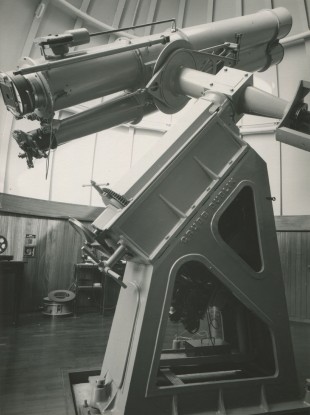
The Astrographic Telescope at Herstmonceux with the Markowitz Moon camera fitted at the breach end. Taken prior to 11 January 1961, the photo also shows the Astrographic's own plate carrier on the floor by the wall (left). Humphry Smith Photographic Archive
The move of the Royal Observatory from Greenwich and Abinger to Herstmonceux took vastly longer than had originally been expected and none of the telescopes of the equatrial group had re-entered service when Markowitz began his measurements in 1955. Had a suitable telescope been available and the Time Service relocated earlier, it is entirely possible that a parallel set of observations might have been made at Herstmonceux at the same time. A dual rate Moon camera was belatedly installed on the 13-inch Astrographic telescope in June 1958 as part of International Geophysical Year (which was scheduled to run from 1 July 1957, to 31 December 1958). It remained in use until 11 January 1961, and according to Leschiutta was able to confirm the results obtained by Markowitz, though no reference was given in his paper.
The definition of the 'atomic' second. Sigfrido Leschiutta, Metrologia 42 (2005)
In his paper Time Scales, Metrologia, Vol 4, No.4, (1968), Louis Essen stated that the value of the frequency of caesium transition which was published in 1958 'was supported by subsequent measurements', but declined to say who carried them out or when they were made. In the same paper, he also wrote:
'Although the National Physical Laboratory published corrections to the frequency of the MSF transmission in terms of the atomic clock it did not integrate the frequency to form a time scale. The first atomic time scale was established by the U.S. Naval Observatory (U.S. Naval Observatory 1959) and the times of the WWV signals were given in terms of this scale from January 1959, being extrapolated back to 1956.'
Intriguingly, there was no mention by Essen of the Greenwich atomic time scale, which Smith first appears to have mentioned in a publication in Bulletin 22 (which was published in 1960). In Bulletin 105 he wrote
'Since 1955 the atomic time scale has been based on the summations of the rates of quartz clocks calibrated in terms of the caesium atomic frequency standard at the National Physical Laboratory. The provisionally adopted frequency of the resonance is 9 192 631 770 cycles per second (E.T.)'
Smith did not state if the scale had been extrapolated back to 1955 or if it had begun to be computed at that time. If computations had begun in 1955, the scale would have had to be subsequently adjusted since the figure of 9 192 631 770 only became available in 1958. In 1985 however, in his excellent and highly recommended comprehensive summary of how different time scales evolved up to the year 1984 (International Coordination of Atomic Time. Humphry Smith, Vistas in Astronomy (1985)), Smith states that Cs1:
'was used to calibrate the quartz clocks at the NPL and at the Royal Greenwich Observatory: these were used to form the Greenwich Atomic Time scale which has been available as a continuous reference since June 1955.'
In their 2005 paper Atomic time-keeping from 1955 to the present, Guinot and Arias state that Essen and Parry developed the first atomic time scale. McCarthy and Seidelmann on the other hand seem to believe that the first was that of the Royal Observatory (Time from Earth rotation to atomic physics, p.225 (2009)).
See also: Essen and the National Physical Laboratory's atomic clock. Dale Henderson, Metrologia (2005)
A new definition of the second was formally adopted as part of the SI system at the Thirteenth General Conference on Weights and Measures in October 1967. Since that date, the second has been defined as ‘the duration of 9,192,631,770 periods of the radiation corresponding to the transition between the two hyperfine levels of the ground state of the atom of caesium133’. The IAU agreed and proposed that the BIH should compute an international atomic time scale (IAT) from the independent atomic time scales of the major national time services. From October 1967 seven establishments including the Royal Observatory contributed to the new time scale. Computation of the scale was considerably improved at the end of 1968 when international time comparisons became possible with the use of Loran-C (a Loran C receiver was installed at Herstmonceux in December 1968). The method of constructing the scale remained unchanged until July 1973 when it was constructed instead from individual clocks, weighted according to their recent performance and the BIH International Atomic Time Scale (TAI) came into being. Although the atomic timescale is now the norm, the later derivatives of ephemeris time are still of importance to astronomers.
On 1977 January 1, by international agreement, the duration of the scale unit of TAI was increased by exactly 10 parts in 1013 (about 32 μS per year) to bring it into closer conformity with recent determinations of the SI second at sea level; the opportunity was taken to make a similar but smaller adjustment in the rate of the local atomic scale, and to change its name from GA2 to TA(RGO). The former uncorrected international time scale continued to be published under the name EAL (Échelle Atomique Libre, meaning Free Atomic Scale).
At the Observatory, UT2 was determined from the GA as was the timing of the various time signals for which the Observatory was responsible. An examination of the Time Service Bulletins and Greenwich Time Reports show a Time Department that was continually evolving as new technology was developed and acquired and definitions of time scales tweaked. The detail is currently beyond the scope of this website. The following links however set out some of the background to the evolution of time measurement at the Observatory. Four Loran-C receivers (one on loan from USNO) have been used to monitor the Synchronization of the emissions, and hence the accuracy of the navigation system; these receivers also link TA(RGO) to TAI.
The introduction and evolution of Coordinated Universal Time (UTC)
UTC is the time by which the world sets its clocks. Broadly speaking, it is International Atomic Time adjusted to stay originally within 0.7 seconds but later within 0.9 seconds of UT1. In effect, it is the modern equivalent of Greenwich Mean Time. Since 1 January 1972, adjustments have been made in steps of exactly one second, normally at the end of June or the end of December as circumstances have required. The one second steps have become known as leap seconds. Donald Sadler (Superintendent of H.M. Nautical Almanac Office) was a staunch opponent of the introduction of the new system, and is said to have worn a black tie in memory of GMT whenever a leap second was introduced.
In his personal history, George Wilkins explained how the introduction of leap seconds had muddied the waters on the definition of Greenwich Mean Time:
'The change had two additional consequences for the UK. Firstly, the BBC 6- pips time signal was changed in two ways. The addition of a leap second was marked by the emission of a seventh pip and the last pip was always lengthened so that if only 5 pips were heard the listener would know whether it was the first or last pip that been lost. Secondly, the signal continued to be known as the Greenwich time signal and it was normally referred to as GMT. Thus once again, the meaning of GMT was ambiguous, as this abbreviation was used for both Greenwich mean solar time, which closely followed the variations in the rotation of the Earth and was the argument in the tables in the navigational almanacs, and for coordinated universal time, which was based on International Atomic Time (TAI). A change in the meaning of GMT had previously occurred in 1925 when the start of the day in the Nautical Almanac was changed from noon to midnight to conform with civil practice and with the recommendations of the prime meridian conference in 1884. The Nautical Almanac continued to use GMT with its original meaning, but it eventually changed to the heading “UT (GMT)”.'
When UTC was first introduced adjustments were made more frequently and in smaller steps. In December 1976, Humphry Smith was the guest speaker at the Eighth Annual Precise Time and Time Interval ( PTTI Applications and Planning Meeting. In his speech, he explained how the move towards coordinated universal time was kick started in 1959:
'It may not be generally known that the present co-ordinated system for radio time signals came into being following the success of an experimental exercise initiated by the USA and UK. The preliminary informal agreement was reached at a meeting in the garden of my house in Bexhill on a sunny afternoon on 19th July 1959. For the record, those present were H Barrell of the NPL and Chairman of the International Committee of Weights and Measures, RL Corke of the British Post Office Radio Branch Laboratories, L Essen (NPL), W Markowitz, Director of the Time Service at the USNO, and D H Sadler, CA Murray, NPJ O'Hora and myself from the RGO. My wife provided tea. A more formal meeting at the USNO on 26 and 27 May 1960 endorsed the arrangements. Markowitz was in the Chair: other participants were Andrews, Hastings and McNish (USA), Corke, Essen and Smith (UK) and, as an observer, Kalra from Canada. The principles were unanimously agreed, but the details left fluid. Markowitz and I were to develop the scheme as circumstances required.'
Royal Observatory Bulletin 22, which covered the first quarter of 1960, carried the following information about how the scheme began in practice:
'The time signals controlled by an observatory are required to conform closely to U.T.2. Instead of adopting a value for the caesium frequency in terms of the current value of the second of U.T.2, it is more convenient to adopt, from time to time, a value of the 'offset' from the nominal caesium frequency, specified in parts in 1010, which corresponds to the current difference in rate between U.T.2. and the atomic scale. From comparisons between the Herstmonceux P.Z.T. observations and Cs1 during 1959, the offset was found to be approximately 150 parts in 1010. This was in agreement with the comparisons made between the P.Z.T. observations of the V.S. Naval Observatory and the U.S. caesium standards. It was therefore decided to adopt an offset of exactly 150 parts in 1010 throughout the year 1960.'
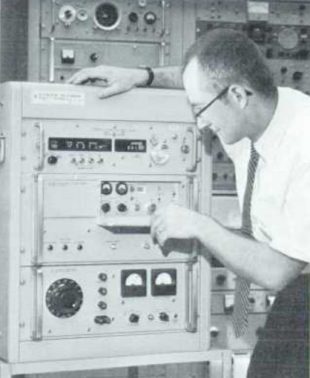
One of the flying clocks being checked by Richard Baugh before starting its journey in the second experiment. The rack has three units. They were the HP115BR electronic clock (top). the caesium standard HP5060A (middle) and the power supply unit (bottom). © 2009 Hewlett-Packard Development Company, L.P. Reproduced from the April 1965 edition of the HP Journal by permission of the Hewlett-Packard Company
For a detailed history of the evolution of UTC see:
The leap second: its history and possible future, R,A, Nelson et al. Metrologia (2001)
See also U.S.
Department of Commerce National Bureau of Standards Miscellaneous Publications 23 (1961)
The flying clock experiments conducted by Hewlett-Packard
In 1964, Hewlett-Packard began a series of four experiments in which the rates of caesium standards in different countries were compared directly with some of its own clocks. In the first, two HP506A frequency standards were transported by air to the Observatoire de Neuchâtel, Switzerland. Each was combined with an HP115BR electronic clock which, among other functions, provided accurate electrical "ticks" from the standard frequency for comparison purposes. Each also had a special standby battery power supply. Since the equipment had to be powered from whatever source might be at hand, the supply was designed to accept power from a variety of frequencies and voltages, including dc voltages.
Although the Royal Observatory did not have a caesium standard of its own until the third experiment took place, it was able to take part in the second and subsequent experiments. The second took place in early 1965, the third in May and June 1966 and the fourth between September and October 1967. The experiments were all written up in the HP Journal, links to which can be found below.
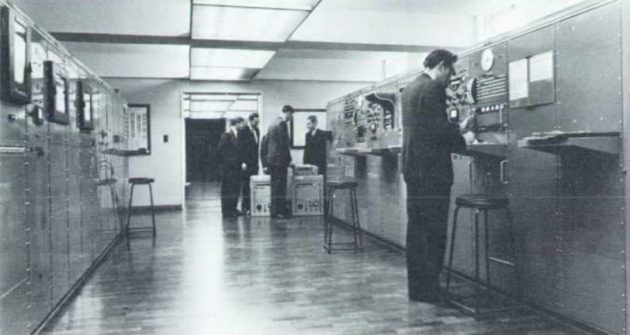
The arrival of the travelling clocks in the Control Room of the Time Department at the Observatory in February 1965. They can be seen on the floor in the centre of the photo. © 2009 Hewlett-Packard Development Company, L.P. Reproduced from the April 1965 edition of the HP Journal by permission of the Hewlett-Packard Company
Table showing the locations and facilities visited during February and March 1965
during the second flying clock experiment*
Place |
Facility |
Time |
Freq |
|
| Koganei, Japan | Standard Broadcast Station JJY | x | x | |
| Kashma, Japan | RRL Tracking Station | x | ||
| Maui, Hawaii | Standard Broadcast Station WWVH | x | ||
| Herstmonceux Castle, Eng. | Royal Greenwich Observatory | x | ||
| Teddington, England | National Physical Laboratory | x | x | |
| Bagneux, France | National Centre for Communication Studies (CNET) | x | x | |
| Paris, France | Paris Observatory | x | x | |
| Stockholm, Sweden | Swedish National Defence Research Institute | x | x | |
| Copenhagen, Denmark | Royal Danish Air Force Calibration Centre | x | ||
| Hamburg, Germany | German Hydrographic Instiute (DHI) | x | ||
| Braunschweig Germany | National Bureau of Physics and Technolgy (PTB) | x | ||
| Neuchâtel, Switzerland | Swiss National Laboratory | x | x | |
| Neuchâtel, Switzerland | Swiss Horological Research Laboratory | x | ||
| The Hague, the Netherlands | Post Telephone and Telegraph | x | ||
| Brussels, Belgium | Royal Observatory of Belgium | x | ||
| Ottawa, Canada | National Research Council | x |
*Reproduced by permission of the Hewlett-Packard Company from the April 1965 edition of the HP Journal, © 2009 Hewlett-Packard Development Company, L.P.
Summary of the four HP flying clock experiments*
| 1964, Apr | Time correlated between U.S. and Switzer land to about 1 microsecond. RF propagation time established within about 200 microseconds. Two clocks operated within a few parts in 1012 of one another and within a few parts in 1012 of "long beam" caesium standards at Neuchatel, Switzerland and NBS at Boulder, Colorado. | |
| 1965, Feb/Mar | Time (or frequency) correlated between 21 places in 11 countries to within 1 microsecond. One clock accumulated less than 6 microseconds time difference and the other less than 1 microsecond in 23 days (compared against NBS UA). | |
| 1966, May/Jun | Time (or frequency) correlated within about 0.1 microsecond between 25 places in 12 countries. Two clocks agreed with each other within 1 microsecond after 31 days with an average frequency difference of less than 3.6 parts in 1011. | |
| 1967 Sep/Oct | Time (or frequency) correlated between 53 places in 18 countries to about 0.1 microsecond. Two clocks exhibited time differentials of 1.7 and 3.5 microseconds over 41 days (compared to HP house standard), corresponding to average frequency differences of 5 X 10-13 and 10 X 10-13, respectively. |
* Adapted from Table 1, p13 of the December 1967 edition of the HP Journal. Reproduced by permission of the Hewlett-Packard Company, © 2009 Hewlett-Packard Development Company, L.P.
The flying clock comparisons conducted with other organisations
From 1964 onwards, numerous visits were made with travelling clocks to Herstmonceux to compare them with the Observatory clocks, with several normally taking place each year. The first visit mentioned in the main Observatory Reports (see link below) took place in October 1964 and involved comparisons between quartz clocks. The last recorded visit took place in July 1976, after which date clock comparisons seem to have been made entirely with the use of Loran-C and the Navigational Technology Satellites. There is also mention of at least one occasion when an Observatory Clock was taken overseas. Slightly greater detail was usually given in the Royal Observatory Bulletins and Greenwich Time Reports.
In 1970, the Observatory took part in an experiment in which comparisons were made with a clock that was being flown over the Observatory. The 1970 Report gave the following account:
'In September the RGO took part in an experiment, operation 'Synchran' (Synchronisation Atlantique Nord) employing a method developed by the French Office National d'Études et de Recherches Aérospatiales for precision intercomparisons between remotely situated clocks. The time difference between a clock carried in an aircraft, whilst the aircraft is in flight, and a clock on the ground, was measured.
The aircraft passed over the Paris Observatory, the Royal Greenwich Observatory, the laboratories of the National Research Council in Canada, and the U.S. Naval Observatory. The scatter of the measures made at Herstmonceux was about 50 ns in bad weather conditions and 30 ns in good weather.'
A brief account with accompanying photo was also published on pages 14-15 of the January 1971 edition of Quest, the House Journal of the Science Research Council (the Observatory's funders). A fuller description was given in National Bureau of Standards Monograph 140 (1974).
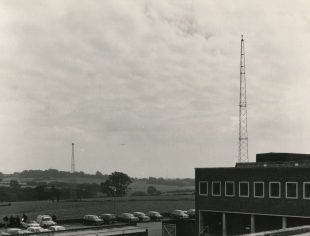
The plane carrying the atomic clock approaching the West Building during operation 'Synchran'. Note the group of staff watching on (bottom left). Humphry Smith Photographic Archive
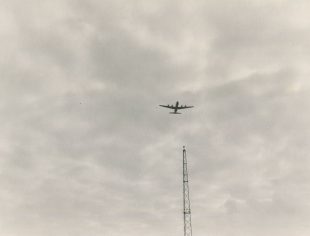
The plane passing over the West Building. The account in Quest identified the plane as both a DC-7C and a DC-75 (which appears to be a typo). Humphry Smith Photographic Archive
The Greenwich Time Signal and atomic clocks
By 1949, phonic motors had replaced the pendulum clocks that had been used to generate the 'six-pip' Greenwich Time Signals that had been broadcast by the BBC since 1924. Originally controlled by the Observatory's quartz clocks, the phonic motors remained in use right up until 1990 when control of the time service was handed over to the BBC (see below).
In 1927, the Observatory also began generating rhythmic time signals that were broadcast by the Post Office from Rugby under the call sign GBR. By 1944, production of the signal had been switched from Shortt Free Pendulum Clocks to phonic motors under the control of quartz clocks. In 1960, an agreement was reached with the National Physical Laboratory and the Post Office for the co-ordination of the GBR signals and the MSF standard frequency transmissions (which were under the control of NPL) with both series of signals being produced and controlled from the same equipment owned by the Post Office at Rugby. As a result, the GBR signals were never produced by the Observatory's atomic clocks, only monitored by them.
The Rugby Time Signals (GBR & MSF)
The evolving time desk in the Time Department Control Room
Over the years, the control desks of the Time Department underwent many changes. The first image of the desk towards the top of this page captures them as originally installed whilst the last at the bottom captures the western side at the end of its working life. Taken less than ten years apart, the two images immediately below record a major transformation in the equipment installed.
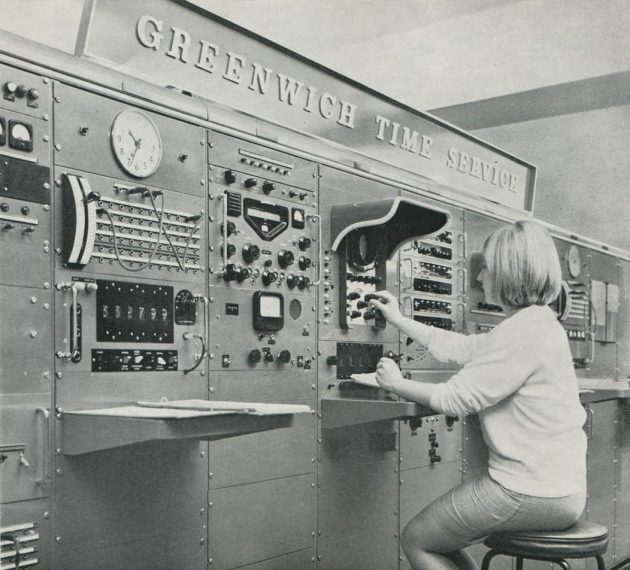
A partially revamped desk for the reception and comparison of radio time signals. Already present by February 1965, oscilloscopes replaced pulse counters to time the arrival of radio time signals from the start of 1967 (Bulletin 148). A staff member can be seen at the controls of one of them. From The Royal Greenwich Observatory Herstmonceux guidebook (1967)
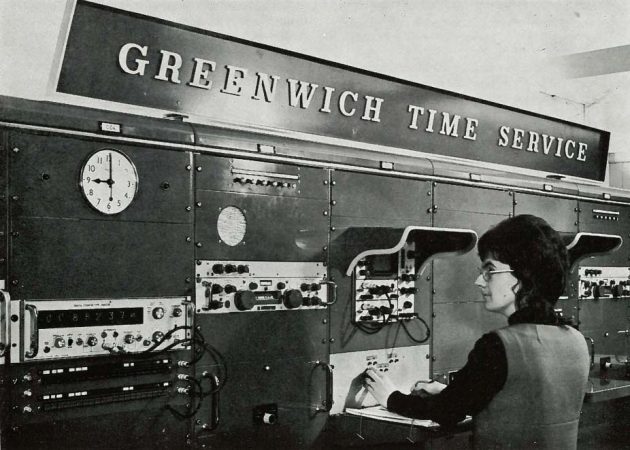
Mrs P Thomas checking the broadcast time signal against the outgoing signal which had been advanced to compensate for the delay in the land line and equipment. RGO photograph c.1974 reproduced from Quest © UKRI Science and Technology Facilities Council. Reproduced courtesy of Chilton Computing (see below)
The time circulars
In his 1949 Report to the Board of Visitors the Astronomer Royal reported that:
'A new service for the benefit of those departments and establishments which maintain accurate frequency standards is the systematic estimation of absolute frequency. A monthly circular giving the estimated frequencies has been prepared and distributed since 1948 April, and a similar weekly service was instituted in 1948 June. The information has proved useful to the recipients, in spite of some uncertainty in the estimate of frequency from the current observations. The definitive reception times of the radio time signals are of necessity published three or four months in arrear, which is too late to be of much use to those who wish to know the current performance of their frequency standards.'
Designed to be ephemeral, copies are hard to come by. The Circulars continued to be mentioned in the Observatory Reports until 1980. It seems likely however that they continued to be produced after that date.
Thr Royal Observatory Bulletins relating to the Time and Latitude Service and the Greenwich Time Reports
The first mention in the Reports of the Astronomer Royal of a Time Service Bulletin containing the reception times of all the radio time signals received at the Observatory, dates back to 1949. A series of Time Service Circulars was started at the same time. Meanwhile, a monthly circular giving the estimated frequencies had been prepared and distributed since 1948 April, with a similar weekly service started in June 1948.
Following his appointment as Astronomer Royal, Woolley discontinued the annual publication of the Greenwich Observations. From 1956 the results were supposed to appear instead in one or other of two new publications that were to be issued at irregular intervals:– The Royal Greenwich Observatory Annals and the Royal Greenwich Observatory Bulletins. The opportunity was taken at the same time, to combine several departmental reports containing ephemeral matter into a new series entitled Royal Greenwich Observatory Circulars. The Time Service Bulletins appear to have been published as before but under the new title of Royal Observatory Bulletins.
Following the merger with the Cape Observatory in 1959, their publications were merged into the RGO series of Bulletins and Annals, but without changing the system of numeration or pagination. To reflect this, the word Greenwich was dropped from the titles, the Bulletins from number 21 onwards, becoming known as the Royal Observatory Bulletins. The original title was restored in 1976 for bulletins number 182 onwards, following the transfer of the Cape Observatory to the Combined South African Observatories (now known as the South African Astronomical Observatory).
Although the bulletins were numbered sequentially, each one was originally assigned to one of five different series (A-E). Within any one series, the bulletins are divided into volumes with the page numbering continuing sequentially from one bulletin to the next – the page numbers being prefixed by the series letter.
The fives series of bulletins were:
A Meridian work (blue covers) – 1 volume
B Time Service / Time and Latitude Service (yellow covers) – 4 volumes
C Solar work (grey covers) – 2 volumes
D Magnetic work (red/brown covers) – 4 volumes
E Astrophysical and astrometric papers, and miscellaneous other work – 7 volumes
None of the publications are available to consult via the SAO/NASA Astrophysics Data System. Nor, apart from Series C have they been made available in digitised form elsewhere apart from a couple digitised for this website. This together with the fact that copies are held in relatively few libraries and archives, means that even today (2022), the information they contain is difficult for most people to access.
When the division of the Royal Observatory Bulletins into five series was discontinued at the start of 1969, the Time and Latitude Service results began to be published as Greenwich Time Report. Although the Reports are not numbered, the pagination continues from one Report to the next, with a third and seemingly final volume being started for the Reports for 1977 onwards (when the page size was also reduced). Like the Bulletins, each Report covered a period of three months except in 1974 and 1980, when the first six months of the year were combined into one issue. Additionally, the 1973 issue for Jul-Sep contained serious errors and a joint issue for the period Jul-Dec issued in its place. The Report for the second quarter of 1982 appears to have been the last to be published. Prior to 1956, similar information had been published in the volumes of Greenwich Astronomical Results.
Numbers assigned to the Time Service / Time and Latitude Service Bulletins
(i.e. the series B Bulletins)
| Volume | Year | Jan-Mar | Apr-Jun | Jul-Sep | Oct-Dec |
| 1 | 1956 | 1 | 2 | 3 | 4 |
| 1957 | 5 | 6 | 7 | 8 | |
| 1958 | 9 | 10 | 12 | 13 | |
| 1959 | 15 | 16 | 19 | 20 | |
| 2 | 1960 | 22 | 32 | 35 | 39 |
| 1961 | 47 | 56 | 59 | 62 | |
| 31 | 1962 | 71 | 74 | 75 | 76 |
| 1963 | 79 | 80 | 83 | 86 | |
| 1964 | 89 | 94 | 96 | 102 | |
| 4 | 1965 | 105 | 113 | 116 | 123 |
| 1966 | 133 | 138 | 140 | 143 | |
| 1967 | 148 | 149 | 150 | 151 |
Notes:
1. At the start of Volume 3, the series name was changed from Time Service to Time and Latitude Service. Volume 3 also contained the following three Bulletins:
- Bulletin 68: Time and Latitude Service 1958-1961
- Bulletin 81: Photographic Zenith Tube: Instrument and method of reduction
- Bulletin 92: Results obtained with a Danjon Astrolabe at Herstmonceux
Bulletins and Greenwich Time Reports available online:
Royal Observatory Bulletins Number 105: Time and Latitude Service 1965 January–March
Greenwich Time Report 1968, Jan - Mar
Greenwich Time Report 1968, Apr - Jun
Greenwich Time Report 1971, Jan - Mar
Greenwich Time Report 1972, Jan - Mar
Greenwich Time Report 1973, Jan - Mar
The RGO archives (RGO22) contains 50 Reports covering the period January 1968 to March 1981, The original Report for 1973 (Jul-Sep), was withdrawn and reprinted in the next issue (see above). There is no copy of the withdrawn issue. The Royal Astronomical Society has a larger set which covers the complete period to June 1982, and includes the withdrawn issue from 1973.
As well as the Bulletins and the Greenwich TIme Reports, the Observatory also published circulars and notices. In the 1976/7 Observatory Report, their frequency of publication was stated as follows:
- Time Circulars A (weekly) - commenced August 1961
- Time Circulars A (monthly}
- Time Service Notices (irregularly)
The Observatory Report for 1968 states that: A new series of Circulars [type unspecified] was inaugurated containing the daily readings or the relative phase difference of the atomic standards and received carriers on selected LF and VLF radio emissions.'
Reports outlining the facilities and services of the Time Department in 1973 and 1986
In 1973, Humphry Smith produced a paper for the Fifth Precise Time and Time Interval Planning Meeting held at Goddard Space Flight Centre in December. In it, he gave a short, but comprehensive summary of the work that took place at Herstmonceux, including sections on comparisons of clocks and the use of satellites for such work.
See also
John Pilkington took over from Humphry Smith as Officer in Charge of the Time Department on 1 October 1976. In this paper, published as part of the Proceedings of the Eighteenth Annual Precise Time and Time Interval (PTTI) Applications and Planning Meeting, Washington, DC, 2-4 Dec 1986, he presents a bleak outlook for the future of the Department describing how a once World renowned pioneering department at the forefront of technology had evolved into a bit-part player in global timekeeping. Trying to remain diplomatic, he appears to have omitted the fact that the Observatory’s six atomic clocks were being left to run down and stop over the next couple of years.
The withdrawal of funding and the running down and closure of the Time Department
On 29 January 1982:
'The Director, Dr G A Wilkins and Dr J D H Pilkington visited the National Physical Laboratory, to discuss the responsibility for time matters. The meeting was held at the suggestion of Mr B W Oakley, Secretary of SERC, who was also present. It was agreed that the time-service activities at both establishments were fully justified and that the accuracy of the timing link between them ought to be improved' Wilkins (2009).
Within the space of just a few years, the Science and Engineering Research Council (SERC) had changed its mind and withdrew most of the funding needed to run the service. This was partly to do with a funding crisis and partly to do with new technologies that meant that it was no longer technically necessary for the RGO to maintain an independent atomic timescale for astronomical purposes.
The 1980s saw a series of serious financial crises hit the the Science and Engineering Research Council (SERC). With 20% of its budget committed to international activities and contributions needing to be paid in foreign currencies, the Council was particularly vulnerable to changes in the exchange rate. In just one week, between 7 and 14 July 1986, currency fluctuations wiped £7 million from its budget. Not only was the Time Department threatened, so too was the future of the Herstmonceux site, which was eventually closed, with the Observatory transferring in a much reduced state to Cambridge in 1990.
The withdrawal of funding for the Time Department clearly happened prior to October 1985, since the issue was specifically mentioned in the Observatory Report for the period ending on 31 September. On 8 November 1985, the story was picked up in The Times when it ran a story under the heading Time catches up with Greenwich. By 1986, the fate of the Department was of sufficient concern, that questions were being raised in both houses of Parliament.
In his article in The Times, Pearce Wright had reported that replacing the caesium tubes of the Observatory clocks would cost £20,000 a clock. When addressing Parliament on 7 March 1986, George Walden a Minister at the Department of Education and Science gave a figure that was twice the size. This is what he said:
'It is estimated that the six atomic clocks at the Royal Greenwich Observatory will fail within the next three years. To replace them would cost about £40,000 per clock, and to maintain the independent time scale would cost about £100,000 per annum in manpower and equipment.'
He also explained that:
'The need for an independent atomic time service is greatly reduced by the availability of the international atomic time scale by satellite, and the observatory proposes to obtain reference to precise time by this means in future. This will involve about £40,000 in capital equipment, and about £20,000 per annum running costs.'
going on to say:
'The need for the Royal Greenwich Observatory to maintain an independent atomic time scale has been greatly reduced by the availability of the international atomic time scale (UTC) via the Navstar—global positioning system (GPS) satellite service. When the clocks fail, the Observatory will continue to assist in the provision of the familiar "six-pips" Greenwich time signal by reference to the UTC.' (Hansard, 7 March 1986)
The figure given for each clock by Walden was twice that given by Wright (presumably because he quoted the price of a new clock rather than a new caesium tube) and suggests that Walden deliberately framed his statement to make the expenditure required sound as large as possible in order to justify the SERC position. At the same time he may have been over-optimistic about the availability of the Navstar system. Further research is needed to establish if it was actually true that UTC could be accessed via GPS at the point when the decision to cut funding was made since the last of the last of the ten Block I satellites was only launched after that date.
A question was also raised but Lord Gainfrod in the House of Lords the following week (Hansard).
By October 1987, Pilkington's role had evolved into that of Officer in Charge of the new Satellite Laser Ranger team and Tony Seabrook (who had been working in the Electronics and Computing section within the Facilities Division) had been put in charge of what remained of the Greenwich Time Service. An alternative precision time service also had to be found, so that the Satellite Laser Ranger could continue to operate. How this was done was described by Seabrook in his paper:
The time desk was closed down during February 1990, the BBC taking over the generation of the six pip time signals.
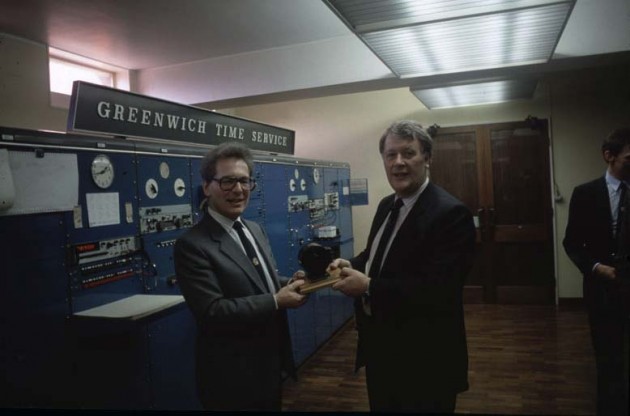
The Observatory Director, Alec Boksenberg (left), with Duncan Thomas, the BBC's Director of Resources, Radio, at the special ceremony held on 5 February 1990 to mark the hand-over of the Time Service. Photo courtesy of Patrick Moore
When the Observatory vacated the Herstmonceux site later that year, the Satellite Laser Ranger was the one thing that didn’t move. On a scientific front, continuity of observation from an established site was of international importance and it was this argument won the day.
See also
Current location of the clocks
When the Herstmonceux site was vacated in 1990, some equipment from the time department was acquired by both the Science Museum (Object Number: 1990-303Pt1) and the British Horological Institute where it is on display at the Museum of Timekeeping at Upton Hall. Each received one of the two HP5060A atomic clocks. One of the later clocks may have gone to Leeds University's Department of Engineering. The fate of the others is unknown.
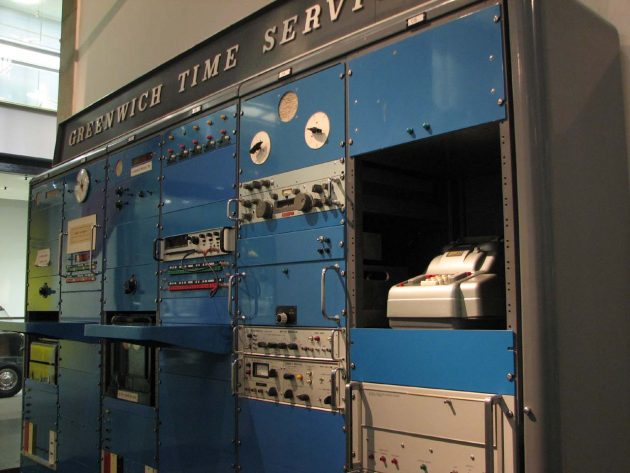
The time service equipment at the Science Museum is contained in six racks labelled C1–C6. The unit is thought to contain representative examples of the equipment used, but not their configuration or relative locations when they were in use. The HP5060A unit that can be seen bottom right would have been in one of the clock cellars. Other equipment in the unit includes two phonic motors and a Loran-C receiver. Photo November 2010
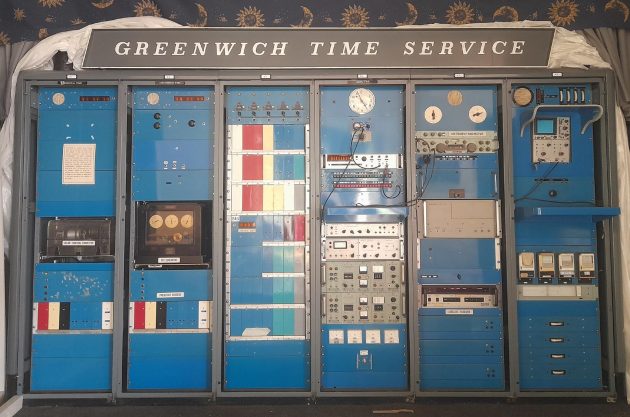
The time service equipment at Upton Hall is contained in six racks labelled A1–A6. As with the unit at the Science Museum, it is thought to contain representative examples of the equipment used, but not their configuration or relative locations when they were in use. The HP5060A unit that can be seen in the fifth rack from the left. Other equipment in the unit includes: Transmitting Motor No.4 which was one of the six pip generators (second rack): Solar-Sidereal transformers No.1 (first rack,), and a Loran-C receiver (fourth rack). Photo May 2024
Further reading
Papers by members of the Observatory staff:
Astronomical Measure of Time, being the Presidential Address of the Royal Astronomical Society given at the anniversary meeting on 9 February 1968. Quarterly Journal of the Royal Astronomical Society, Vol. 9, p.281
The Bureau International de l’Heure. Humphry Smith, 8th Annual Past Time and Time Interval (PTTI) meeting 1976
The Evolution of TAI and UTC. Humphry M Smith, IETE Journal of Research, 27:10, 407-414 (1981)
The steady march of atomic time Humphry Smith, New Scientist 11 February 1982
Other papers and books in chronological order:
The Science of Timekeeping. Hewlett Packard Application Note 1289 (1997). Alternative link
Coordinated Universal Time UTC: Historical background and perspectives. E.F. Arias, B. Guinot (2005)
Essen and the National Physical Laboratory's atomic clock. Dale Henderson, Metrologia (2005)
Fifty years of commercial caesium clocks. Leonard S Cutler. Metrologia 42 (2005)
Acknowledgements
The photograph of the HP5061A clock at the top of the page is reproduced under a Creative Commons Attribution 2.0 Generic license (CC BY 2.0) courtesy of Dave Jones and (see below). It was downloaded from flickr and has been cropped and compressed for use here.
The photograph marked © UKRI Science and Technology Facilities Council is reproduced courtesy of Chilton Computing was accessed from Quest, Vol 7, No1
© 2014 – 2025 Graham Dolan
Except where indicated, all text and images are the copyright of Graham Dolan
